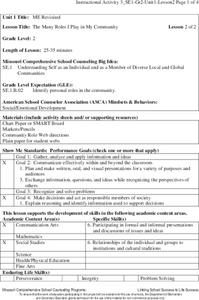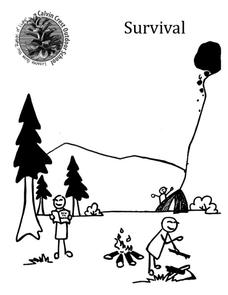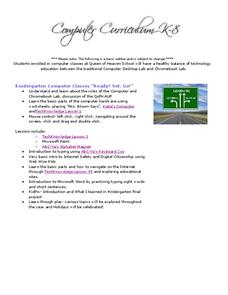Education Center
Star Rules
Why are rules so important? Just ask the main characters in the children's book Officer Buckle and Gloria. After a class read aloud, compare and contrast the safety tips mentioned in the story with your classroom rules, noting any...
Nemours KidsHealth
Car and Bus Safety: Grades K-2
Nearly every child will ride in a car or take a bus during their elementary career, that's why it is so important to teach them safety skills. First, little ones discuss why safety rules are important. Then, they go over rules that will...
Do2Learn
Safety: Fire Safety
In the case of a fire emergency, provide greater support and instruction for students who require it using this collection of picture cards. The cards include images and words that describe a variety of fire safety...
Nemours KidsHealth
Water Safety: Grades K-2
Learners identify bathtub and pool safety rules. In this water safety lesson plan, students create a bathtub safety book and water bottle label that contain pool and water safety rules.
In Working Order
Life Skills Lesson Activities
Examine the proper procedures and guidelines of Occupational Health and Safety with activities designed for high schoolers. Job seekers learn how to identify and remedy common workplace hazards, and to mitigate risk when possible.
Education Center
Safety Tip
Practice safety tips after reading Officer Buckle and Gloria with your first graders. A fun coloring page encourages kids to write a safety tip in a police officer's badge, then illustrate how to follow the tip.
Council for the Curriculum, Examinations and Assessment
Safety and Managing Risk
Teenagers love to take risks to test their personal boundaries, but many risks are too dangerous to try. The set of exercises in this packet teach your class about the ways they can stay safe and protect themselves while still having fun.
Nemours KidsHealth
Fire Safety: Grades K-2
Learners navigate the Internet to view sites on fire safety. In this fire safety lesson, students answer questions, complete worksheets and make a poster demonstrating their ability to react safely in a fire.
Curated OER
Our Classroom Constitution
Develop a system of classroom rules created by the kids, for the kids with this three-part lesson series on the US Constitution. After learning about the structure of the Constitution and the government it established, young...
Curated OER
Tell Me; I’ll Listen
Encourage respect, responsibility, and caring within your classroom with a collection of lessons that spark dialogue and self reflection. To address character traits, lessons touch on topics such as staying safe in the...
Common Sense Media
Going Places Safely
How can places on the Internet be dangerous? Youngsters draw important connections between traveling online and staying safe in the real world. They also discover three key online safety rules to guide them throughout their...
Rainforest Alliance
Who Takes Care of the Maya Forest Corridor?
Who keeps animals safe? Who keeps us safe? Discover the helpers that make learning and growing possible through a medley of activities that focus on habitats—ours and those in the rainforest. Scholars are asked to identify one...
Nemours KidsHealth
Safe and Healthy Summer: Grades 3-5
Scholars become familiar with a tool designed to ensure a safe and healthy summer. Following the "5-2-1-Almost None" rule, pupils eat five or more servings of fruits and vegetables, keep screen-time under two hours, be physically active...
Missouri Department of Elementary
The Many Roles I Play in My Community
Small groups brainstorm their roles in the community. Then, individually, complete a community roles web worksheet. Peers share their completed product and extend the conversation to include the feelings and character traits that go...
KOG Ranger Program
Matches, Lighters, and Kids Do Not Go Together!
Do your part to prevent forest fires with an activity about not playing with matches. A word search prompts young rangers to fill in the blanks about the consequences of playing with matches, and a set of pictures provides spaces for...
KOG Ranger Program
Leading Causes of Wildfires in Oregon
You've heard of "wildfire season," but what types of weather and conditions lead to increased wildfires? Young firefighters learn about common sources of wildfires, safe ways to clear debris near their homes, and the most effective ways...
abcteach
Story Starter: Stop Sign
If you're looking for simple writing prompts for young children then stop right there, because we have what you need. Including a picture of a stop sign and four sets of handwriting lines, this exercise asks young writers to...
Education Center
Oops!
Teach safety, as well as cause and effect with one worksheet. Kids cut the bottom boxes on the page and paste them in the correct places to show what happens when you don't follow safety rules. Though it's designed for Officer...
Calvin Crest Outdoor School
Survival
Equip young campers with important survival knowledge with a set of engaging lessons. Teammates work together to complete three outdoor activities, which include building a shelter, starting a campfire, and finding directions in the...
Scholastic
Opioids and the Overdose Epidemic
Learn about the opioid and overdose epidemic in America with an article that explains what opioids are, how they are used, and how they are abused. Learners discover the death rates associated with opioid overdoses and other factors that...
Queen of Heaven School
Computer Curriculum
Need some extra resources to get your class computer savvy? How about several years' worth? Show pupils in K-8 a progression of proficiency in a series of computer lessons. Learners master the basics, then work with the Microsoft Office...
Curated OER
Citizenship Worksheet 5 - Local and State Government
The Tenth Amendment of the United States Constitution delegates rights that have not been defined by the federal government to the states. But what are the responsibilities of state governments? What about county and city governments?...
C3 Teachers
C3 Teachers: Inquiries: Rules
A comprehensive learning module on rules that includes three supporting questions accompanied by formative tasks and source materials, followed by a summative performance task. Students examine who makes rules, what following rules looks...























